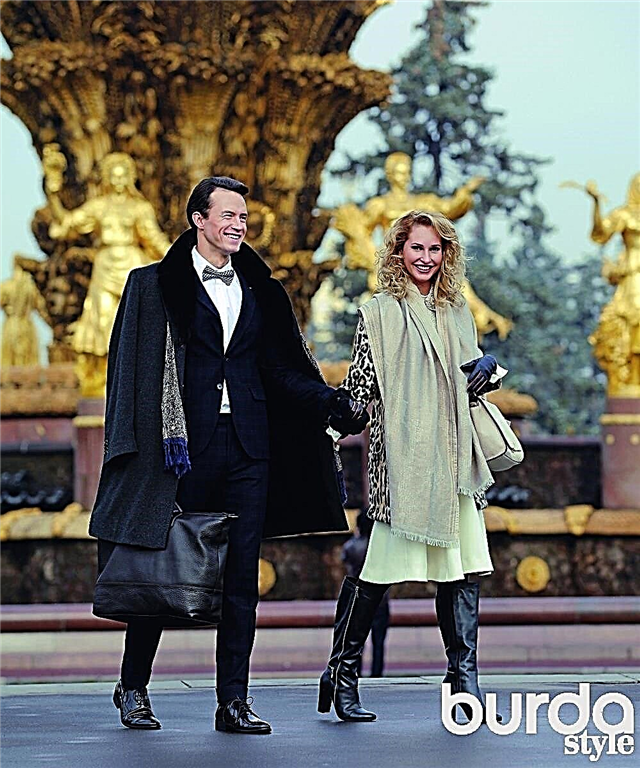Share
Pin
Tweet
Send
Share
Send
Who would have thought that a piece of cloth that would save a warrior or a tired traveler in bad weather would become a prestigious piece of wardrobe? It happened with a tie.
 Diamonds and Butterflies
Diamonds and ButterfliesEurope, XVII century. Batiste is in fashion neck scarfwhich is wrapped several times around the neck, leaving the ends hanging loose on the chest. Fashionistas spent half a day at the mirror in order to tie a neck scarf according to all the rules.For example, a silk ribbon was tied over it, making a large bow under the chin. This type of neck scarf was called a "tapeworm", or "diamond." And the first woman to wear a tie was the favorite of Louis XIV, Louise Lavalier. She tied her neckerchiefs with a bow tie. This knot, named after her "Lavalier", is used today - with different variations.
In the era of the French Revolution, men wore wide scarves of white cloth, and the rebels found a place for confrontation here - they put on a black tie ("black as a curse"). In England, at this time, a tie was a mandatory attribute of a real gentleman. Soon, pretentiousness disappeared from the men's suit, and it turned out that only with the help of an original tie can individuality and style be emphasized.
Around the same years in Russia, Peter I tried to make a tie mandatory for wearing at court. But, like many of the innovations of the pro-European king, the tie at first had a hard time. Peter was forced to issue the rules for using the new accessory, where he reminded that "it is not worth rubbing off with a tie and it is not ordered to blow your nose into it." As a result, they didn’t like such a useless thing in Russia for a long time, they called it “noose” and “snake”.
Talking detail
In Europe, at the beginning of the 19th century shirts with a collar came into fashion. The role of the tie in men's clothing became the main one, this "talking detail" was a kind of "calling card", by which you could find out almost everything about its owner. “A man is worth the same as his tie - he is himself, he covers his essence with them, his spirit is manifested in him,” said Honore de Balzac, one of the first fashionistas in France. In 1827, he dedicated a book to a tie, which became a bestseller of the time.The heroes of his work, entitled “The Art of Wearing a Tie,” became a “Byron-style tie” - a loose, wide-knitted shawl; a “tragic” black tie - a detail of mourning and uniform; “Walter Scott” - from checkered fabric; ceremonial “white” a tie "for dinner parties ... An ordinary person, according to Balzac, could immediately be recognized by a" tie without imagination. "
By the beginning of the 20th century, there were three types of ties: the bow tie, ascot (in the form of a neckerchief, tied in the classical way, with ends hidden under a shirt) and regattas. Regatta - and there is a modern tie, improved by Jess Langsdorfom. In 1924, this American entrepreneur patented the "perfect tie" - sewn from three parts tailored along the oblique. And he made a fortune by selling a patent to almost all countries of the world.
Around the same time, in the wake of emancipation, ties penetrated the women's wardrobe and forever won a place for themselves among lace, silk and boas. Refined beauty Marlene Dietrich proved that this detail of the men's toilet only adds femininity. Tender Audrey Hepburn used instead of ties neckerchiefstying them with a knot. And modern movie and stage stars are happy to wear ties even on red festival tracks with the confidence that the men's accessory makes them even more attractive.
Ties today
In modern fashion there are no clear rules that determine the color, pattern, shape and length of a tie. Taste and style determines the choice. Some wear it with a club jacket, others on a naked body or T-shirt.And yet, according to the rules, a tie should not be wider than the lapels of the jacket and should end above the trouser belt; for relief materials, it is advisable to wear only ties made of smooth fabrics without printed patterns. Large drawings are contraindicated undersized, and diagonal stripes are full to the face. There are many nuances, but there is another solution: do not wear this accessory at all. So many men did, starting with the hippie movement and the student revolution of '68. It was then that unbuttoned collars, the so-called male neckline, came into fashion. However, the fashion for ties, like any other fashion, is prone to cycling. And the haute couture masters every year write a new page in the history of ties, which does not end there yet.
The article was published on the basis of the journal "Good advice" 11/2014
Text: Olga Kononova. Photo: PR
Material prepared by Julia Dekanova
Share
Pin
Tweet
Send
Share
Send



